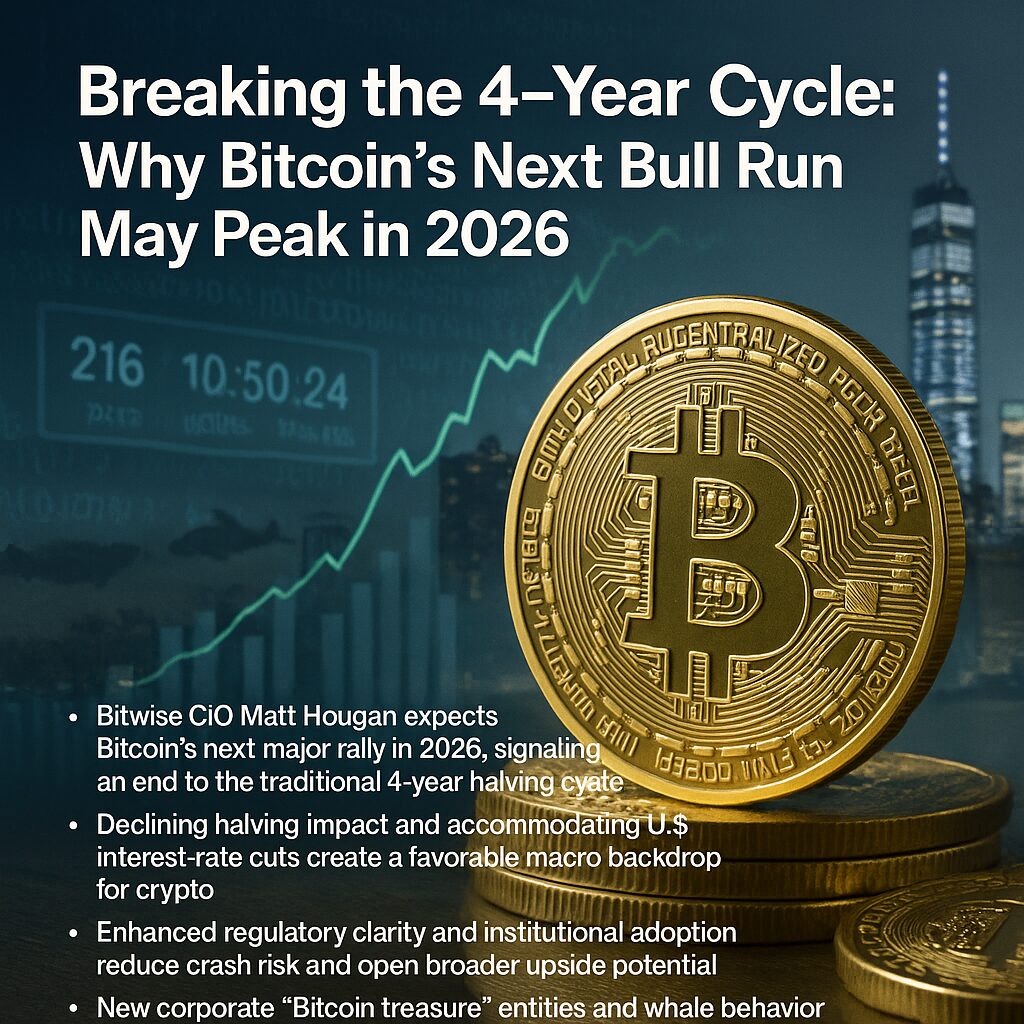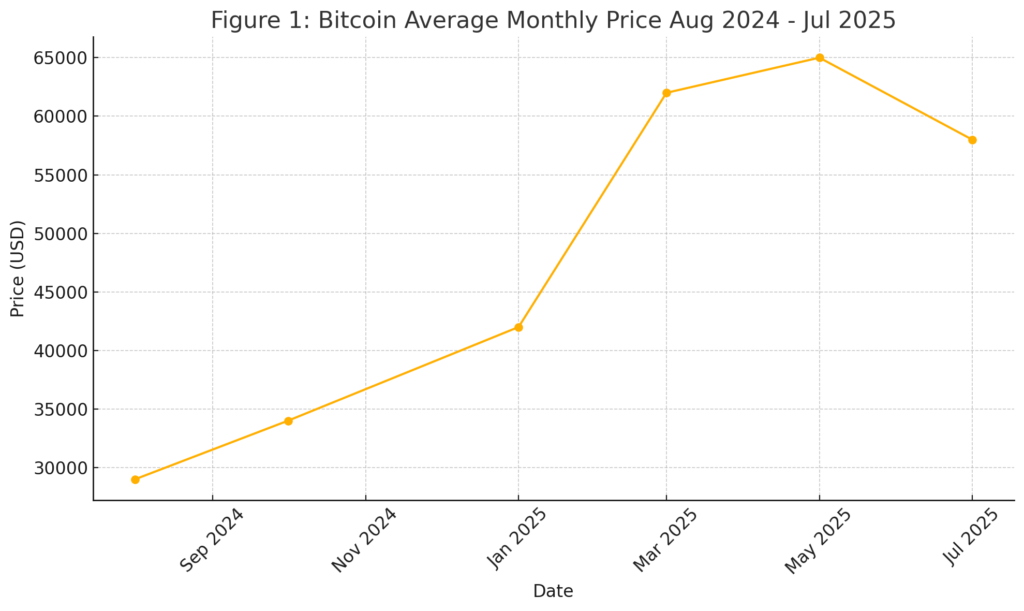
Main Points:
- Bitcoin’s halving cycle is losing its predictive power as macro factors take precedence
- U.S. interest-rate cuts and declining bond yields create a favorable backdrop
- Regulatory clarity and institutional adoption reduce tail-risk and expand upside
- Corporate treasury accumulation and “new whales” signal a structural shift
- Expect a sustained, steady uptrend rather than a short-lived “super-cycle” spike
1. Introduction: A New Era Beyond the Halving
Bitcoin’s traditional 4-year halving cycle has driven price rallies since inception. Yet, as we approach the 2026 halving, Bitwise CIO Matt Hougan predicts that Bitcoin may not peak “in a few months” after the event, but rather experience its next major bull run throughout 2026. This marks a potential paradigm shift: markets may now respond more to interest-rate policies, regulatory frameworks, and institutional flows than to pre-programmed supply shocks.
Figure 1: Bitcoin Average Monthly Price Aug 2024 – Jul 2025

2. The Waning Impact of the 4-Year Halving
2.1 From Supply Shock to Diminished Shock
Historically, each halving—when miner rewards are cut in half—reduced new supply and sparked demand-driven rallies. But the “halving premium” has dropped by roughly 50% with each cycle. By 2026, that premium may no longer be sufficient to override broader market forces.
2.2 Price vs. Time: Is Timing Still Everything?
Analyst firm Rekt Capital warns that if Bitcoin follows the 2020 cycle, a peak could arrive just 550 days after the April 2024 halving, around October 2025. Yet Hougan argues the real drivers now lie outside that window, forecasting sustained strength into 2026.
3. Macro Tailwinds: Interest-Rate Cuts and Weaker Bonds
3.1 Interest-Rate Cuts on the Horizon
U.S. President Trump publicly urged Fed Chair Jerome Powell to cut rates in April 2024. With bond yields and time-deposit rates sliding, Bitcoin becomes relatively more attractive to yield-seeking capital. Markets are pricing at least two 25-basis-point cuts by mid-2025, a shift that historically correlates with risk-asset rallies.
3.2 Flight from Fixed Income
As the yield on the 10-year U.S. Treasury dips below 3.5%, investors hunt for alternative stores of value. Bitcoin’s “digital gold” narrative gains strength, especially as real yields turn negative.
4. Regulatory Clarity and Institutional Adoption
4.1 From Wild West to Main Street
SEC approvals of spot Bitcoin ETFs in the U.S. and new frameworks in Europe and Asia are reducing compliance headaches. As of July 2025, cumulative inflows into U.S. spot BTC ETFs have topped $10 billion, demonstrating growing institutional confidence.
4.2 Tail-Risk Reduction
Improved custody solutions, clearer tax rules, and stronger AML/KYC frameworks mean that sudden shocks—like the collapse of a major exchange—carry less systemic risk than in prior cycles.
5. The Rise of Corporate “Bitcoin Treasuries”
5.1 New Whales on the Block
Public companies issuing stock or debt to buy Bitcoin (so-called “treasury companies”) now hold over 500,000 BTC on balance sheets. While VanEck warns that leveraged accumulation could amplify downside in a crash, these entities also signal deeper, more patient demand.
5.2 Whale Behavior Shift
Traditional whales have historically sold into retail rallies. But today’s “old whales” are selling to “long-term whales”—institutional investors focused on HODLing rather than flipping.
6. Forecast: A “Smooth Boom,” Not a Super-Cycle
6.1 Less Volatility, More Consistency
Hougan expects 2026’s bull run to unfold as a steady, multi-quarter uptrend rather than a blow-off spike. This is due to the broadening base of participants—from sovereign wealth funds to corporate treasuries—providing stable bid.
6.2 Preparing for the Unexpected
“Volatility remains,” Hougan admits, “and I could be wrong.” But even conservative models point to Bitcoin reaching at least $200,000 by end-2026 under current ETF inflows and rate-cut assumptions.
7. Recent Trends and Supporting Data
7.1 Exchange Net Flows
Data from CryptoQuant show that exchange outflows have exceeded inflows in six of the past eight weeks, indicating stronger buy-and-hold behavior.
7.2 Derivatives Open Interest
CME Bitcoin futures open interest sits near all-time highs, a sign that both institutional and retail traders are positioning for higher prices.
8. Conclusion: Positioning for 2026
In light of fading halving effects, favorable macro conditions, robust regulatory structures, and the maturation of institutional demand, Bitcoin’s next major rally may well span all of 2026. Investors seeking new crypto opportunities should consider strategic accumulation now—balancing profit-taking discipline with the prospect of a sustained uptrend.

